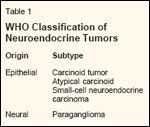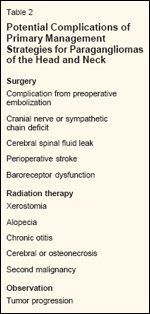Commentary (Barker/Garden): The Multidisciplinary Management of Paragangliomas of the Head and Neck
We have reviewed with interestthe article by Drs. Huand Persky and would liketo congratulate them on an excellentand comprehensive overview of theevaluation and management ofparagangliomas of the head and neck.Their review begins with an excellentlydetailed description of thedisease and staging work-up. Withmodern imaging, most paragangliomasare convincingly diagnosed basedon typical location (carotid bifurcation,nodose ganglia of the vagusnerve, middle ear along tympanic plexus,or near jugular bulb) and characteristicradiographic appearance(hypervascular, intensely enhancingmass). A tissue diagnosis is usuallyunnecessary for such lesions.
We have reviewed with interest the article by Drs. Hu and Persky and would like to congratulate them on an excellent and comprehensive overview of the evaluation and management of paragangliomas of the head and neck. Their review begins with an excellently detailed description of the disease and staging work-up. With modern imaging, most paragangliomas are convincingly diagnosed based on typical location (carotid bifurcation, nodose ganglia of the vagus nerve, middle ear along tympanic plexus, or near jugular bulb) and characteristic radiographic appearance (hypervascular, intensely enhancing mass). A tissue diagnosis is usually unnecessary for such lesions.
TABLE 1

WHO Classification of Neuroendocrine Tumors
Less commonly, however, paragangliomas can arise in the larynx, nasopharynx, or other head and neck mucosal subsites where the differential diagnosis includes the broader family of neuroendocrine tumors[1,2]- for example, carcinoids, atypical carcinoids, neuroendocrine carcinoma, and small-cell carcinoma (Table 1). It is important to secure an accurate diagnosis in this situation, as management and prognosis vary dramatically.
Although paragangliomas generally are benign and managed with local treatment alone, other neuroendocrine tumors (small-cell carcinomas, atypical carcinoids, neuroendocrine carcinomas) require local, regional, and systemic therapies and carry a much poorer prognosis. In fact, it is likely that pathologic confusion would explain the relatively high rates of "malignant paraganglioma" reported in some series.[3] Immunohistochemically, paragangliomas usually do not stain for cytokeratin; in addition, their characteristic lack of calcitonin expression can distinguish them from atypical carcinoids.[4,5]
Treatment Strategies
Without a randomized comparison of treatment alternatives (surgery, radiation therapy, or even observation) to guide decision-making, clinicians are currently forced to rely on available retrospective data. Despite the inherent limitations and biases of retrospective data from predominantly single-institution reported series, surgery and radiation therapy appear to produce similar rates of long-term local control (~90%). This similarity is seen even though patients treated with radiation therapy generally have larger or more infiltrative tumors that are not readily subject to surgical resection. In addition, these relatively high rates of local control do not improve with more aggressive combination approaches.[6]
TABLE 2

Potential Complications of Primary Management Strategies for Paragangliomas of the Head and Neck
Treatment decisions, therefore, are usually dependent on the side-effect profiles of the various approaches (Table 2). Technical advances in both surgery (vascular management, skullbase approaches, nerve grafting) and radiation therapy (three-dimensional conformal radiation therapy, intensitymodulated radiation therapy [IMRT], image-guided treatment planning, stereotactic radiosurgery) are decreasing the incidence of toxicities related to these modalities.
Historically, in the 1960s and 1970s radiation was used more commonly in the management of these diseases.[7] Management strategies swayed significantly toward the use of surgery in the 1980s and 1990s. This trend correlated with the growth and development of interventional vascular radiology and microvascular and skull-base surgery. It also provided a subjective sense of improved out- come to treating clinicians in that local control truly meant no evidence of disease rather than just the absence of tumor progression. However, it was recognized that, even in the hands of expert skull-base surgeons, moderate rates of complications are seen, including cranial nerve deficits in 39% of cases and a mortality rate of 2.7%.[8] This has led to greater individualization of management options.
Recommendations
We generally recommend a primary surgical approach for younger patients with lesions that are readily resectable without significant postoperative neurologic impairment. This approach avoids both the small risk of a radiation-induced second malignancy and the risk of chronic xerostomia among patients with the longest life expectancy. For patients with bulky lesions in whom aggressive resection risks severe cranial nerve deficit or for patients who are not medically fit for surgery, we recommend primary radiation therapy. Serial observation remains a reasonable management option, especially in the asymptomatic older patient.
When primary radiation therapy is selected, we agree with the recommendation of Drs. Hu and Persky that a conventionally fractionated external- beam approach be used in most patients. We also treat to a total dose of 45 to 50 Gy (2 Gy/fraction) and to a volume encompassing the gross radiographically visible tumor plus small margin to account for setup variation. These tumors are usually irregularly shaped and found in close proximity to radiosensitive normal tissue structures (optic structures, brain, brainstem, spinal cord, parotid glands); they represent ideal targets for conformal radiation approaches. IMRT, for example, can deliver full doses of radiation to the target-even relatively bulky lesions-while delivering much lower doses to neighboring parotid glands. Although stereotactic (single, high-dose) techniques are advocated by some, there is less experience with this approach, and the available follow-up is less mature than with conventionally fractionated approaches.[9,10]
Disclosures:
The author(s) have no significant financial interest or other relationship with the manufacturers of any products or providers of any service mentioned in this article.
References:
1. Ferlito A, Barnes L, Rinaldo A, et al: A review of neuroendocrine neoplasms of the larynx: Update on diagnosis and treatment. J Laryngol Otol 112:827-834, 1998.
2. Shanmugaratnam K, Sobin LH: Histological typing of tumors of the upper respiratory tract and ear, in: World Health Organization International Histological Classification of Tumours Series, 2nd ed. Berlin, Springer-Verlag, 1991.
3. Batsakis J, El-Naggar A, Luna M: Pathology consultation: Neuroendocrine tumors of the larynx. Ann Otol Rhinol Laryngol 101:710-714, 1992.
4. Martinez-Madrigal F, Bosq J, Micheau C, et al: Paraganglioma of the head and neck: Immunohistochemical analysis of 16 cases in comparison with neuroendocrine neoplasms. Pathol Res Pract 187:814-823, 1991.
5. Ferlito A, Friedmann I: Contribution of immunohistochemistry in the diagnosis of neuroendocrine neoplasms of the larynx. ORL J Otorhinolarygol Relat Spec 53:235-244, 1991.
6. Powell S, Peters N, Harmer C: Chemodectoma of the head and neck: Results of treatment in 84 patients. Int J Radiat Oncol Biol Phys 22:919-924, 1992.
7. Tidwell TJ, Montague ED: Chemodectomas involving the temporal bone. Radiology 116:147-149, 1975.
8. Jackson CG, McGrew BM, Forest JA, et al: Lateral skull base surgery for glomus tumors: Long-term control. Otol Neurol 22:377- 382, 2001.
9. Maarouf M, Voges J, Landwehr P, et al: Stereotactic linear accelerator-based radiosurgery for the treatment of patients with glomus jugulare tumors. Cancer 97:1093-1098, 2003.
10. Foote RL, Pollock BE, Gorman DA, et al: Glomus jugulare tumor: tumor control and complications after stereotactic radiosurgery. Head Neck 24:332-338, 2002.
Newsletter
Stay up to date on recent advances in the multidisciplinary approach to cancer.